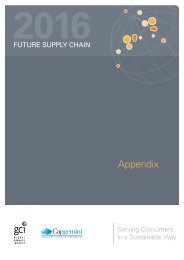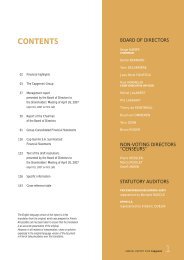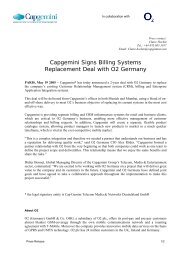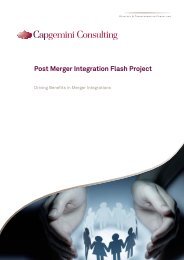Transportation Management Report 2011 - Capgemini
Transportation Management Report 2011 - Capgemini
Transportation Management Report 2011 - Capgemini
You also want an ePaper? Increase the reach of your titles
YUMPU automatically turns print PDFs into web optimized ePapers that Google loves.
33<br />
Figure 13: TMS functional reference model and domains<br />
Strategic<br />
Tactical<br />
Operational<br />
Transport<br />
Sourcing<br />
Capacity<br />
<strong>Management</strong><br />
Shipping<br />
Consolidation<br />
and load / trip<br />
planning<br />
Load Design<br />
Route Planning<br />
Fleet & Driver<br />
Planning<br />
Carrier Selection<br />
Planning<br />
Performance<br />
<strong>Management</strong><br />
Asset & Fleet<br />
<strong>Management</strong><br />
Order Entry &<br />
Consolidation<br />
Dispatching<br />
Yard<br />
<strong>Management</strong><br />
Execution<br />
Monitoring<br />
Order Status<br />
Information<br />
Parcel<br />
<strong>Management</strong><br />
In order to achieve the best possible<br />
cost/benefit ratio when designing<br />
the functional architecture, it is<br />
recommended that you map the<br />
business processes using as many<br />
off-the-shelf standard services as<br />
possible. The number of customer<br />
individual services should be reduced<br />
to a minimum. The more business<br />
capabilities that can be supported<br />
by standard services the less budget<br />
will be required for individual service<br />
development and maintenance.<br />
Network design<br />
Resource<br />
<strong>Management</strong><br />
Global Logistic<br />
Execution<br />
Customs &<br />
Transport<br />
Documents<br />
Vehicle<br />
<strong>Management</strong><br />
Route Planning<br />
Communication<br />
Contract<br />
<strong>Management</strong><br />
Rate & Tariff<br />
<strong>Management</strong><br />
Carrier /<br />
Subcontractor<br />
Invoice<br />
Settlement<br />
Customer Billing<br />
Freight Bill<br />
Auditing<br />
Execution Vehicle<br />
Finance<br />
Transport Cost<br />
Allocation<br />
Time & Labour<br />
Another important factor to consider<br />
during this phase is the structure of<br />
the existing landscape. It needs to be<br />
segmented along the same principles<br />
as the target landscape so that you<br />
can already be considering options to<br />
transition functionalities towards the<br />
To-Be and optimize the target design<br />
accordingly.<br />
Within the SOPS approach<br />
<strong>Capgemini</strong> uses industry specific<br />
reference models (process models,<br />
domain models) to accelerate the<br />
required categorization and mapping<br />
activities (Figure 13).















